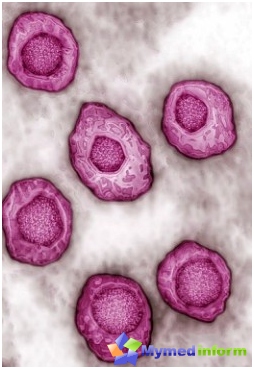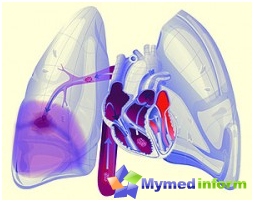Pathogenesis during the period of infectious mononucleosis

When infectious mononucleosis penetrates the respiratory tract, it leads to the deformation of the epithelium and lymphoid tissue of the mouth and nasal pharynx. In this case, mononucleosis causes the swelling of the mucous membrane, an increase in almonds and lymph nodes on the neck. Next, the virus penetrates into cytoplasm in lymphocytes, spreading throughout the body. When infectious mononucleosis spreads throughout the body, then fabric hyperplasia begins in the body.
If the infectious mononucleosis is resumed in B-lymphocytes, then the active division of cells and their expansion in plasmocytes begins, which in turn allocate immunoglobulins of low specificity. Infectious mononucleosis is a disease that even if you exercise long and correct treatment, the virus still remains in the body throughout life. As a result of the presence in the human body, mononucleosis reduces immunity and can manifest itself at any time. If infectious mononucleosis is expressed by immunological reactions, then the disease can be considered a disease of the immune system, as a result of which infectious mononucleosis belongs to the complex group AIDS - associated diseases.
What provokes the occurrence of infectious mononucleosis
Infectious mononucleosis caused by the DNA genomic virus of the herpes family. This type of virus has the ability to replicate. But unlike other viruses that exist in the human body, the DNA genomic does not destroy the cells and does not lead to their death. On the contrary, this virus activates cell proliferation (growth). Full-fledged particles of the virus (virions) include specific antigens:
- capsid
- nuclear;
- early;
- Membrane.
Each of these elements is formed in the sequence and is responsible for the synthesis of the corresponding antibodies. If the person has infectious mononucleosis, antibodies to the capsid antigen appear in the blood of the patient, and then antibodies to nuclear and membrane antigens are produced. When drying, the causative agent of the infectious mononucleosis will quickly die, so the virus can not be long in the external environment. Such a phenomenon is associated with the impact of high temperature and disinfectants.
The source of excitation of infectious mononucleosis is a person who has a manifest or erased form of illness. In the last days of the incubation period, as well as for 6-18 months after a primary infection, the carriers of infectious mononucleosis are distinguished by a virus, thereby infecting surrounding people. 15-25 percent of healthy people are also possible to discover mononucleosis in flushing. If a person has previously suffered an infectious mononucleosis virus, it still allocates the causative agent of the disease with its saliva for a long time.
How the infectious mononucleosis is transmitted
Mononucleosis is transmitted by aerosol air-droplet. Often infectious mononucleosis is transmitted from a sick person or carrier to healthy with saliva. The virus can pass when kisses, Sex contact, Through hands, household items and toys. The fact that mononucleosis can be picked up when blood transfusion, as well as during childbirth.
Most people have a high natural susceptibility to the disease, but often the erased and light forms of infectious mononucleosis are most often dominated. If a child, during the first year of life, rarely sick mononucleosis, this indicates a congenital passive immunite, which is capable of rejecting mononucleosis. In the state of immunodeficiency in humans, an infectious mononucleosis infection contributes to the generalization of the virus.
Signs of infectious mononucleosis

If the first signs of infectious mononucleosis appeared during pregnancy, the woman appeared, then you need to urgently contact the doctor to clarify the diagnosis. In addition, the doctor will prescribe adequate treatment that will not harm the fetus and the course of pregnancy in general. It is important to remember that tightening a visit to the doctor is unacceptable, because everyone knows that during pregnancy is very difficult to be treated from any diseases. This is due to the fact that during the recovery period, it is impossible to take strong drugs.
It is also worth knowing that infectious mononucleosis can lead to serious complications, to be treated for quite a long time. And if mononucleosis appeared before pregnancy, then you should wait with the conception of the child to complete recovery from the disease. After all, if the infectious mononucleosis will turn into a chronic form, it may threaten the following consequences:
- changes in blood;
- gap spleen;
- meningitis;
- arrhythmia, blockade, pericarditis;
- acute hepatic insufficiency;
- Atxia;
- angina;
- Otitis.
And if at least one of the above diseases appear during pregnancy, it threatens serious consequences to resolve the situation. In addition, mononucleosis makes the body vulnerable to different infections, the presence of a woman in the body during pregnancy is absolutely not needed. And the main thing! The virus causing infectious mononucleosis is oncogenic, so our site advises to follow your health and take care of yourself, especially if the disease appeared during pregnancy.
How to treat infectious mononucleosis

Infectious mononucleosis of light and moderate shape can be treated at home. To do this, it is necessary to observe the bed mode with severe intoxication. If mononucleosis proceeds with the manifestation of hepatitis, then a diet is needed during the treatment of the disease. Also to treat mononucleosis helps rinse throat with antiseptic solutions. If the patient has bacterial complications, then appoint antibiotics.
In the event that infectious mononucleosis proceeds with hyperstoxic symptoms or with a threat of asphyxia, which can lead to a pharynx edema and a pronounced increase in tonsils, then a short course treatment is prednisone inside (this is a drug that relates to gluchorticoids) for 3-4 days.









